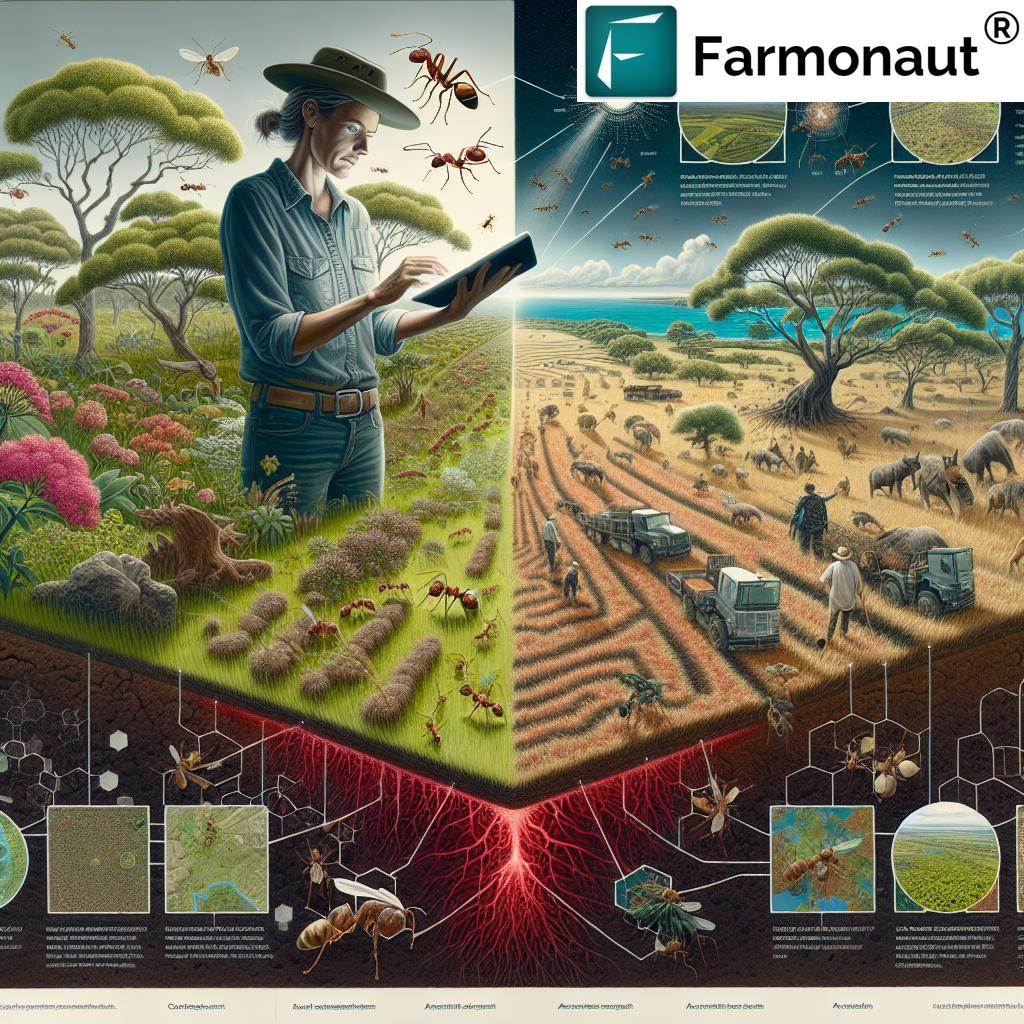Urgent: Queensland’s Battle Against Red Imported Fire Ants – Impact on Agriculture and Biosecurity Measures

“Red Imported Fire Ants could potentially cost Australia A$45 billion in damages to agriculture and ecosystems.”
In the heart of Queensland, Australia, a tiny but formidable enemy has been waging war against our agricultural landscape and native ecosystems. The Red Imported Fire Ant (RIFA), scientifically known as Solenopsis invicta, has become a critical threat to our nation’s biosecurity and agricultural prosperity. As we delve into this urgent matter, we’ll explore the far-reaching impacts of these invasive pests and the crucial measures being taken to combat their spread.
The Red Imported Fire Ant Menace
Red Imported Fire Ants, originally from South America, have found their way to Australian shores, creating a biosecurity nightmare for our agricultural sector. These aggressive insects are not just a nuisance; they pose a significant threat to our environment, economy, and way of life. Their ability to spread rapidly and adapt to new environments makes them a formidable foe in the realm of invasive species management.
- Rapid colonization of new areas
- Aggressive behavior towards humans and animals
- Potential to disrupt native ecosystems
- Significant impact on agricultural productivity
The urgency of addressing this issue cannot be overstated. With potential costs reaching an astounding A$45 billion, the RIFA infestation is not just a local problem for Queensland but a national concern that demands immediate and sustained attention.
Impact on Australian Agriculture
The agricultural sector stands as the front line in the battle against Red Imported Fire Ants. These pests pose a multifaceted threat to farming operations across Queensland and potentially the entire country. Let’s break down the various ways RIFAs impact our agricultural landscape:
- Crop Damage: RIFAs feed on seeds and seedlings, causing significant damage to crops before they even have a chance to mature.
- Livestock Interference: These ants can attack and injure livestock, particularly young or vulnerable animals.
- Equipment Damage: RIFAs can infest and damage electrical equipment, leading to costly repairs and downtime.
- Reduced Land Value: Infested properties may see a decrease in land value, affecting farmers’ assets.
- Increased Production Costs: The need for continuous pest control measures adds to the overall cost of agricultural production.
As agricultural technology experts, we at Farmonaut recognize the critical role that advanced pest management strategies play in combating threats like the Red Imported Fire Ant. Our satellite-based farm management solutions offer valuable tools for monitoring and managing agricultural lands, which can be instrumental in early detection and response to RIFA infestations.
Biosecurity Measures in Australia
Australia’s biosecurity system is renowned for its robustness, but the RIFA invasion has put it to the test. The Department of Agriculture, Water and the Environment has been at the forefront of implementing stringent biosecurity measures to prevent the further spread of these ants. Some key strategies include:
- Strict quarantine protocols for potentially infested areas
- Rigorous inspection of imported goods, especially those from RIFA-prone regions
- Public awareness campaigns to educate communities about identification and reporting
- Collaboration with international partners to share knowledge and resources
These measures are crucial in containing the spread of RIFAs and protecting our agricultural industries. However, the battle is far from over, and continuous vigilance is required.
The National Fire Ant Eradication Program
“The National Fire Ant Eradication Program in southeast Queensland faces ongoing challenges with persistent infestations despite eradication efforts.”
At the heart of Australia’s fight against Red Imported Fire Ants is the National Fire Ant Eradication Program. This ambitious initiative, primarily focused on southeast Queensland, represents a coordinated effort between federal, state, and local governments to eliminate RIFA from Australian soil. The program employs a multi-pronged approach:
- Systematic surveillance and monitoring of infested areas
- Targeted treatment using approved insecticides
- Biological control research and implementation
- Community engagement and education programs
Despite significant efforts and resources poured into the program, challenges persist. The resilience and adaptability of RIFAs have made complete eradication a complex and ongoing process. This underscores the need for continued funding, research, and innovative approaches to pest management.
Sustainable Pest Control Methods
In our quest to eradicate Red Imported Fire Ants, we must balance effectiveness with environmental responsibility. Sustainable pest control methods are crucial for long-term success without compromising our ecosystems. Some promising approaches include:
- Integrated Pest Management (IPM): Combining biological, cultural, and chemical control methods for a holistic approach.
- Bait Treatments: Using low-toxicity baits that target RIFA colonies while minimizing impact on non-target species.
- Biological Control Agents: Introducing natural predators or pathogens specific to RIFAs.
- Habitat Modification: Altering environments to make them less suitable for RIFA establishment.
These methods align with our commitment to environmental conservation in farming, ensuring that our fight against RIFAs doesn’t come at the cost of broader ecological health.
Explore Farmonaut’s API for advanced agricultural insights
Innovative Suppression Techniques
As we continue to battle Red Imported Fire Ants, innovative suppression techniques are emerging as game-changers in pest management. These cutting-edge approaches combine scientific research with practical application:
- Pheromone Disruption: Using synthetic pheromones to confuse and disrupt RIFA mating patterns.
- Gene Drive Technology: Exploring genetic modifications to reduce RIFA populations over generations.
- Smart Traps: Developing AI-powered traps that can identify and target RIFAs specifically.
- Remote Sensing: Utilizing satellite and drone technology for early detection of RIFA colonies.
At Farmonaut, we recognize the potential of agricultural technology in pest management. Our satellite-based crop health monitoring systems can play a crucial role in identifying areas at risk of RIFA infestation, allowing for proactive measures to be taken.
Access Farmonaut’s API Developer Docs for integration into your agricultural systems
Environmental Impact and Conservation Concerns
While the agricultural impact of Red Imported Fire Ants is severe, their environmental impact is equally concerning. These invasive pests pose a significant threat to Australia’s unique biodiversity:
- Displacement of native ant species and other invertebrates
- Predation on small mammals, reptiles, and ground-nesting birds
- Alteration of soil chemistry and structure
- Potential impacts on pollination services
Conservation efforts must be integrated into our RIFA management strategies to ensure that our fight against these pests doesn’t inadvertently harm the ecosystems we’re trying to protect. This delicate balance requires careful planning and execution of control measures.
The Role of Agricultural Technology in RIFA Management
In the digital age, agricultural technology plays a pivotal role in pest management, including the fight against Red Imported Fire Ants. Advanced tools and techniques are revolutionizing how we detect, monitor, and respond to RIFA infestations:
- Satellite Imagery: High-resolution satellite data can help identify potential RIFA habitats and track their spread.
- AI and Machine Learning: These technologies can analyze vast amounts of data to predict RIFA movements and optimize treatment strategies.
- IoT Sensors: Networked sensors can provide real-time data on soil conditions and ant activity.
- Mobile Apps: User-friendly applications allow farmers and the public to report RIFA sightings instantly.
Farmonaut’s advanced agricultural solutions, including our Jeevn AI Advisory System, contribute to this technological arsenal against pests like RIFAs. By providing real-time crop health data and AI-driven insights, we empower farmers to make informed decisions about pest management and resource allocation.
Stakeholder Engagement and Public Awareness
The battle against Red Imported Fire Ants is not just a task for governments and agricultural experts; it requires the engagement of all stakeholders and the general public. Effective stakeholder engagement strategies include:
- Regular community meetings and workshops
- Partnerships with local councils and landowners
- Collaboration with industry groups and environmental organizations
- Citizen science initiatives for RIFA monitoring
Public awareness is crucial in early detection and reporting of RIFA infestations. Educational campaigns, informative websites, and social media outreach play vital roles in keeping the community informed and involved in the eradication efforts.
Funding and Resource Allocation
The success of the National Fire Ant Eradication Program hinges significantly on adequate funding and proper resource allocation. The Australian government, along with state and local authorities, has invested heavily in this battle, but the ongoing nature of the threat requires sustained financial commitment:
- Long-term budget planning for eradication efforts
- Investment in research and development of new control methods
- Allocation of resources for public education and engagement
- Funding for technological advancements in pest detection and management
The economic impact of RIFAs far outweighs the cost of eradication efforts, making continued investment in this program a necessity for Australia’s agricultural and environmental future.
International Cooperation and Knowledge Sharing
The fight against Red Imported Fire Ants is not unique to Australia. Many countries around the world are grappling with similar invasive species challenges. International cooperation and knowledge sharing are crucial for developing effective strategies:
- Participation in global pest management forums
- Collaborative research projects with international institutions
- Shared databases of RIFA behavior and control methods
- Exchange programs for pest management experts
By learning from global experiences and sharing our own insights, we can enhance our ability to combat RIFAs and other invasive species more effectively.
The Future of RIFA Management in Australia
As we look to the future of Red Imported Fire Ant management in Australia, several key areas will likely shape our approach:
- Advanced Biotechnology: Developing species-specific control methods through genetic research
- Predictive Modeling: Using big data and AI to forecast RIFA spread and optimize interventions
- Ecosystem-based Management: Integrating RIFA control with broader environmental conservation efforts
- Policy Adaptation: Evolving biosecurity policies to address emerging challenges and opportunities
The role of agricultural technology companies like Farmonaut will be crucial in this evolving landscape. Our commitment to innovation and sustainable farming practices aligns perfectly with the needs of modern pest management strategies.
Comparative Analysis: RIFA Impact and Control Measures
| Aspect | Current Status | Potential Impact | Control Measures |
|---|---|---|---|
| Agricultural Costs | Significant crop and livestock losses | Up to A$45 billion | Integrated Pest Management, Baiting |
| Environmental Impact | Localized ecosystem disruption | Widespread biodiversity loss | Habitat modification, Biological control |
| Biosecurity Measures | Quarantine and inspection protocols | Enhanced national biosecurity framework | Advanced detection technology, Stricter import controls |
| Eradication Program Funding | Ongoing government investment | Long-term economic savings | Sustained funding, Public-private partnerships |
| Technological Solutions | Satellite monitoring, AI-driven predictions | Real-time tracking and rapid response | IoT sensors, Drone surveillance, Farmonaut’s satellite-based solutions |
Conclusion: A Call to Action
The battle against Red Imported Fire Ants in Queensland and potentially across Australia is a critical challenge that requires our immediate and sustained attention. The potential impact on our agricultural sector, environment, and way of life is too significant to ignore. As we’ve explored throughout this article, a multi-faceted approach combining advanced technology, sustainable pest control methods, and collaborative efforts is essential for success.
We at Farmonaut are committed to contributing our expertise in agricultural technology to this crucial fight. Our satellite-based farm management solutions and AI-driven insights can play a vital role in early detection, monitoring, and management of RIFA infestations. By embracing innovation and working together, we can protect our farms, preserve our ecosystems, and secure a sustainable future for Australian agriculture.
Let’s stand united in this battle against Red Imported Fire Ants, leveraging the best of science, technology, and community engagement to safeguard our land and livelihoods.
FAQ Section
- Q: What are Red Imported Fire Ants?
A: Red Imported Fire Ants (RIFA) are invasive pests originally from South America, known for their aggressive behavior and potential to cause significant damage to agriculture and ecosystems. - Q: How do Red Imported Fire Ants impact agriculture?
A: RIFAs can damage crops, injure livestock, infest farm equipment, and increase overall production costs for farmers. - Q: What is the National Fire Ant Eradication Program?
A: It’s a coordinated effort by Australian governments to eliminate RIFA from the country, focusing primarily on southeast Queensland. - Q: How can technology help in managing RIFA infestations?
A: Advanced technologies like satellite imagery, AI, and IoT sensors can aid in early detection, monitoring, and management of RIFA populations. - Q: What can individuals do to help combat Red Imported Fire Ants?
A: Individuals can stay informed, report RIFA sightings to authorities, and follow recommended biosecurity measures to prevent spread.





















